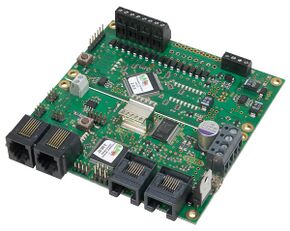OpenDCC GBM (GBM)
Command Station:
Fichtelbahn: OpenDCC GBM (GBM)Summary: The OpenDCC GBM is a DIY command station from Fichtelbahn. It is part of the manufacturer range of BiDiB enabled products.
| See more Command Stations | |
|---|---|

| |
| General information | |
| Manufacturer | Fichtelbahn |
| Compare Prices | Latest Prices
|
| Common Name | OpenDCC GBM |
| Product information
| |
| Product URL | External Product Link |
| Product Manual URL | External Product Link |
| Firmware Upgrade Possible |
Yes |
| Details
| |
| Integrated Throttle | None |
| Throttle Network | BiDiB |
| DCC Features
| |
| Feedback | Yes |
| Speed Steps | |
| Booster | |
| Max Current | 4 |
Description
The OpenDCC GBM is a DIY command station from Fichtelbahn. It is part of the manufacturer range of BiDiB enabled products. This command station is focused on computer control and contains an USB port for connection to a PC running model rail control software.
The GBM contains a 4 Ampere booster. It contains a 16-fold output via an embedded GBM16T module. These 16 outputs are feedback capable, so they can detect train occupancy of each block. They are also Railcom enabled so train identification is possible. (Assuming a Railcom enabled decoder is installed on the locomotive).
The GBM command stations can be extended with two further GBM16T modules so in total one GBM with two GBM16T can provide 48 occupancy detection and feedback track blocks.
Architecture
In a BiDiB device network one GBM acts as a master and is responsible for interfacing with the PC software and generating the DCC signal. If further boosters are necessary more GBMs can be connected to the BiDiB network via standard CAT-6 network cables. Each of these will act as a slave to the master GBM.
Other BiDiB enabled devices can be connected to network. These include:
- Points (turnouts) decoders
- Servo motor decoders
- Light control decoders
- Relay switch decoders
- S88 interface devices.
GBM FAQs
- No FAQs link to this page.
See Also
Articles Referencing this Page
Related Fichtelbahn Command Stations
No other Command Stations found. Feel free to add one.